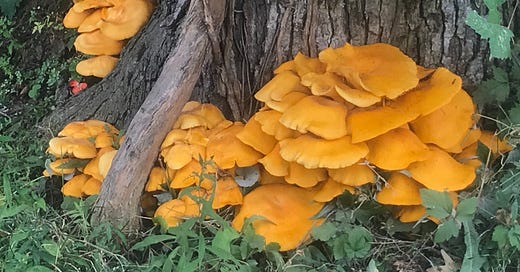You may know that, like many others, I’m fascinated with fungi, mosses, and lichens. Recently, I’ve been reviewing articles and books I’ve read on fungal networks and trying to find a way to write about what we can learn from them about how to live today. What stayed with me most is a line from Merlin Sheldrake’s fascinating book, Entangled Life, “fungi are inventive, flexible, and collaborative.”
When we think of fungi, we usually think of mushrooms, but these are just the fruit of fungi. Mushrooms are good to eat, although some are poisonous to humans and others are medicinal drugs, whether psychedelic or healing. However, the living body of fungi, called mycelium, is hidden underground, in the form of a vast network of tiny thread-like filaments called hyphae. The threads keep subdividing, creating an extensive underground network with nodes where they branch off.
Sheldrake says that fungi challenge the concept of individuality, intelligence, and life itself. They are the roots of all subsequent life on land and have been around for billions of years. In Louis Schwartzberg’s film, Fantastic Fungi, they are called “the digestive tract of the forest.” They decompose material at the end of life and regenerate the soil. In other words, they support the continuation of life for all.
Mycorrhizal Networks
What’s most remarkable about mycelium is that they partner with the roots of trees and plants, to create an extensive underground communications and resource network that transfers water, nitrogen, carbon and other minerals, as well as information, between them. This is called a mycorrhizal network (coined the ‘wood wide web’). The plants engage with the light and air and create sugars through photosynthesis, while the fungi and plant roots engage with the ground, absorbing minerals and other nutrients. Then, they make trade deals.
Toby Kiers is an evolutionary biologist who has studied how fungal networks operate in a similar way to market economies. Her research suggests that, like market trade deals, there are compromises, trade-offs, and strategies. And, there is inequality, with parasites at one end of a continuum and cooperative mutualists at the other. All collaborative partnerships involve some elements of competition and cooperation. It all depends on the spirit of the negotiations. Watch her TED talk, Lessons from Fungi on Markets and Economics.
Sheldrake says, “One of the things we might learn from fungi is that to adapt and to move through this mess (meaning ecological disruption), we will need to form new types of relationship with non-human, more-than-human organisms, but also with humans, and across human ages, cultures, different points of view, disciplines.”
To recap, these underground networks are decentralized and horizontal (non-hierarchical). They share resources and communication, decompose and regenerate. They are flexible, moving around obstacles and adapting as needed, often by forming new partnerships that benefit all members. You’ll find at the end of this post some excellent resources if you want to learn more.
Taking a Pause
Which brings me to share that I’ll be taking a break from writing here until September. I feel as though I need to focus on family and take some time to reflect and explore new avenues, especially locally. I’ll be looking at the networks of support in my own place. In the meantime, here’s a suggestion if you like structured practices.
In 2021, I offered weekly exercises in Seeing Clearly. The first email, on listening, went out on January 3rd, and you can find it here.
In 2022, I offered weekly exercises around Seeing your Place, that is the place where you live. The first email went out on January 2nd, and you can find it here.
I may be revisiting some of these exercises as well during my time away and I’ll be posting on Instagram if you want to follow along there.
How about you? How are you handling these times? What networks are you a part of? What partnerships do you need to form? I’d love to know in the comments.
Resource List
Entangled Life: How Fungi Make Our Worlds, Change Our Minds & Shape Our Futures, the book by Merlin Sheldrake
Fantastic Fungi, a film by Louis Schwartzberg
Invisible Landscapes, a conversation with Merlin Sheldrake and Barney Steel via Emergence Magazine
Why the Hidden World of Fungi is Essential to Life on Earth, via Resilience
Samantha Clark on The Paradox of Patience - where she introduces the idea of mycelial networks and ‘soft rebellion’ from Shannon Willis





Your essay got me to thinking about complex networks and systems of all kinds, and how humans are so cavalier about ripping them to shreds and believing everything will be just fine. Oh my.
Enjoy your hiatus, Kim. Only so much energy to go around!